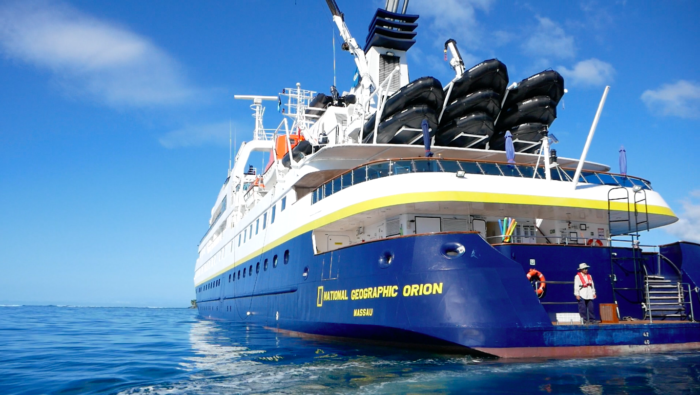
If you were offered the chance to sail from Fiji to Tahiti, exploring islands and diving the warm tropical waters all along the way, whilst onboard the magnificent National Geographic Orion thanks to Lindblad Expeditions, chances are you would say yes as fast as I did!
Before embarking on our expedition from Lautoka in Fiji, I had the priviliege of meeting one of the founding fathers of the Our World Underwater Scholarship in 1972, Dr Joe MacInnis and hear about his latest work. This involved creating a documentary for my generation for which he was busy interviewing leading experts and influential individuals, including Valerie Taylor who I was lucky enough to have onboard my expedition.

Welcomed onboard by the Expedition Team, I knew we were going to be in for an unfortgettable journey. For two weeks we were immersed in new cultural, island-based and underwater experience everyday! From traditional Fijian village culture such as kava ceremonies, to hiking in Dravuni, kayaking and diving in Vanua Balavu, we were so lucky to get the chance to explore such remote parts of the Pacific.


Taveuni Island is the third largest island in Fiji and we were lucky enough to visit the village of Waitabu on our last day in Fiji. The village, with the aid of marine biologist Helen Sykes, initiated a Marine Protected Area (MPA) for Tourism to conserve marine resources for future generations in 1998. Since the initiation of the Waitabu Marine Park, which was one of the first MPAs to exist in Fiji, it became one of the founding members of the Fiji Locally Managed Marine Areas (FLMMA) in 2001. Over time species richness has vastly increased and annual monitoring of the area has allowed the community to improve the ecological state of the marine park. Guided tourism by locals brings small income to the village, allowing reinforcement to the community of the benefits protecting the reef surrounding their village. We were also fortunate enough to be able to hike up into the forest, for a stunning view over the lagoon where the ship had anchored and giving us the opportunity to swim at a magnificent waterfall.

Next we sailed to Futuna and Alofi Islands, also known as Wallis & Futuna. I had never even heard of these islands until I read the itinerary for this expedition. After a sight-seeing and cultural tour of the French claimed islands, with stunning white beaches, lush greenery, crystal clear blue waters and some of the friendliest people you could ever meet, we were lucky enough to see cultural highlights such as the chief’s cannibal oven, but as soon as the opportunity arose, Jayne and I slipped back under the surface to explore the underwater world.

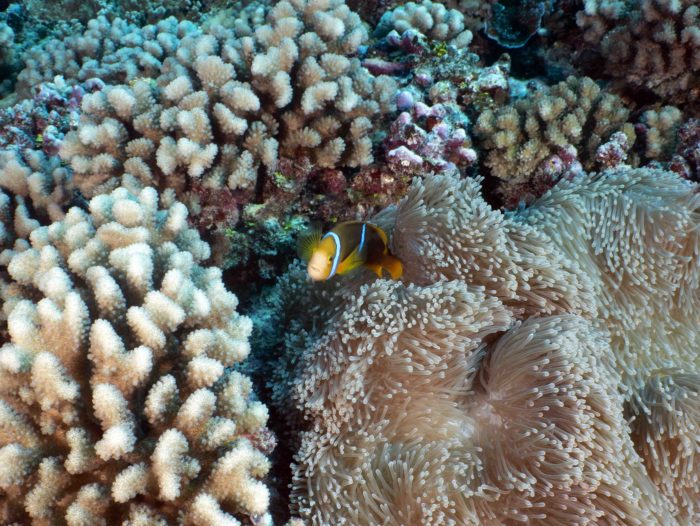
Local guides in Asau, Savai’i, and Apia, Upolu, Samoa, also provided us with some unique diving in yet another part of the Pacific, where were lucky enough to explore old plane wrecks as well as beautiful swim throughs, with reefs exploding full of life from hundreds of species of fish, invertebrates and so many other species!

At sea En Route to the Cook Islands and to French Polynesia we were provided with some wonderful entertainment from the hotel staff with many amazing hidden talents and thanks to Jacob Edgar, the ethnomusicologist onboard who provided us with an authentic musical experience for each of the island regions we visited by bringing local artists onboard. Two days at sea gave us lots of time to sit on the bridge and take in so much of the open-ocean wildlife that we were passing along the way. This also included a perfect opportunity to learn many of the tropical bird species from naturalists and orthinologists Mike Greenfelder and Jamie Coleman. Along the way we saw so many species, a few included Great Crested, Grey Backed, White Naped and Sooty Terns; Black, Brown and White Noddies; Red-footed and Brown Boobies; Great and Lesser Frigate birds; Shearwaters and Tropicbirds to name a few.

Once we reached Aitutaki, Cook Islands, we were greeted with sunny blue skies and crystal clear waters. Brooke, our local dive guide, took us to explore one of her favourite reefs not far from where the ship was anchored and where we were greeted by the gorgeous Napolean Wrasse, Frank! The diving in the Cook Islands was definitely a highlight of the expedition, particularly with so many fantastic interactions with the large charismatic animals such as Frank, lots of large female Green Sea Turtles, to a group of over 50 Spotted Eagle Rays!

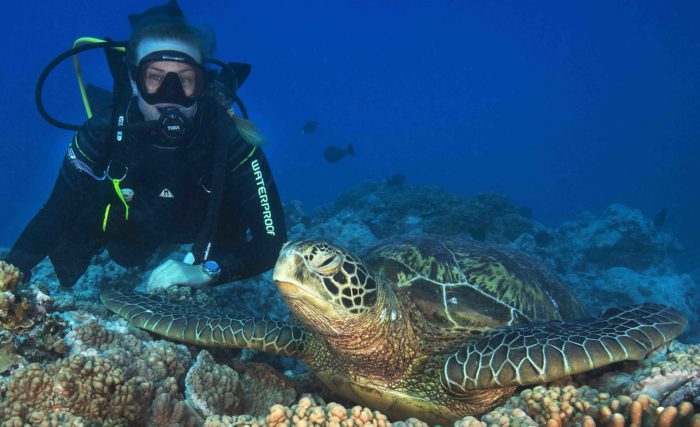
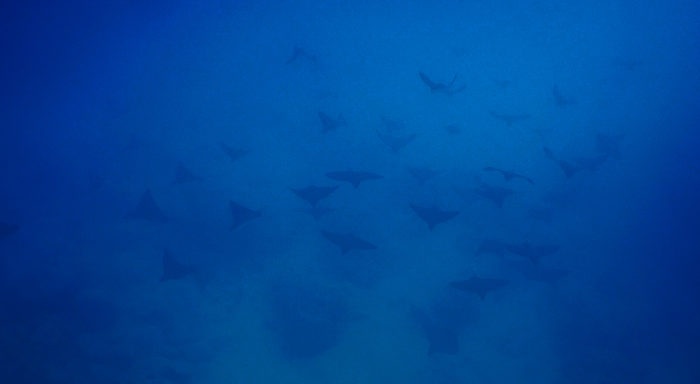
Finally, we arrived in French Polynesia and it was spectacular! We spent the afternoon on Ra’iatea, Society Islands, exploring the Taputapuatea maraes, a UNESCO World Heritage site. The maraes played a central role in pre-Christian life in the islands as they were the epicenter of the powerful Oru cult, whose priests conducted many ceremonies on the site, and any sailor wishing to travel to the far ends of Polynesia had to pass by the site to gain permission from the gods.
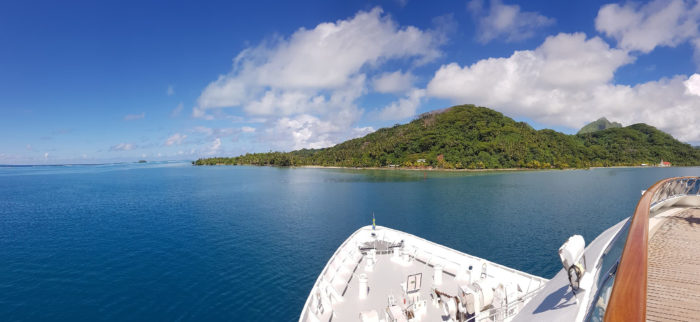

Our last day was very special, the weather was perfect and our final two dives were just outside the channel of Taha’a, Society Islands, guided by local French dive guides allowed deep blue dives off the zodiacs. We were delighted to see some of the best and healthiest hard coral reefs we had seen the whole expedition!!! We then spent the afternoon on Motu Mahaea, a stunning barrier island built up by fringing reef, where we snorkelled, listened to local music and enjoyed a stunning sunset to end the journey.

Not only did this incredible expedition offer the opportunity to wake up in a new place and explore everyday, I also got the opportunity to learn from renowened National Geographic photographers such as Michael Melford and Michael Nolan, listen and learn from lectures by the naturalists, all of whom are leading specialists in so many different fields, as well as hear and dive alongside the Undersea Specalist and fellow Australian for the expedition, Chris Cook.

It is virtually impossible to sum-up the two amazing weeks I had learning about and exploring Polynesia in a blog – I was certainly sad to leave the ship to say the least! I cannot thank Jimmy White and the phenomenal Lindblad Expedition team and hotel staff enough for hosting me and providing me with this incredible experience, opportunity to explore this part of the world, learn about local traditions and community conservation efforts. I would particularly like to thank Cristian Moreno for leading such wonderful dives!
Again, this opportunity would not be possible without the incredible support from OWUSS, Rolex, Waterproof International, TUSA, DAN, PADI, Mako Eyewear. A huge thank you to Reef Photo & Video and Nauticam who have allowed me to capture the moments above and below the surface along the expedition.